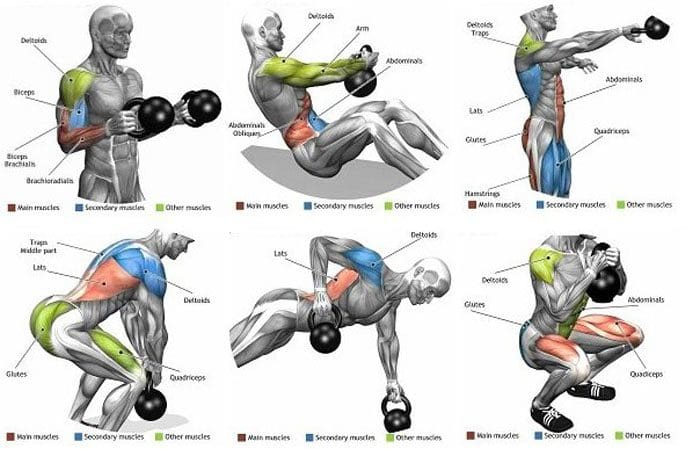
Kettlebell training for the back muscles and back pain prevention can be part of a recommended treatment plan. When experiencing low back pain, many sports medicine experts recommend kettlebell exercise to strengthen the core and posterior chain. However, if not used correctly, kettlebell exercises can worsen back pain.

Table of Contents
Kettlebell
They are made of cast iron or steel and are named for resembling a tea kettle with an oversized handle. They can be used in one and two-handed movements.
Exercises and Movements for Back Pain
For individuals that are not experiencing back pain, kettlebell training can be excellent for maintenance and injury prevention. They strengthen the core and back muscles.
- The kettlebell swing is an essential exercise and is one of the most important exercises when dealing with back pain issues.
- A kettlebell is placed on the floor about 12 inches in front while standing with the feet a little wider than hip-distance.
- The hips become the hinge.
- Extend the arms down to the bell and grip it.
- Begin swinging it up and down through the legs and then upward and outward to chest level.
- The shoulders are to stay relaxed.
- The hips are used to thrust and create momentum to swing the kettlebell.
- Keep the spine neutral throughout the exercise to prevent injury.
- The arms are to hold the bell only.
- Don’t swing with the arms or shoulders, but push through with the hips.
- The exercise can be swung up over the head but is not recommended for those with back pain.
Benefits
- They are portable and don’t require a lot of space.
- With kettlebells, an individual can train more easily than with barbells.
- Kettlebell workouts provide strength training and cardiovascular fitness.
- Once the proper technique is learned, individuals can set up a regular regimen at home.
Proper Form and Mistakes
Proper form is crucial. The primary movement most individuals have difficulty with is getting the proper hinging motion at the hip. Most individuals flex at the lower back and place increased pressure on the discs. Proper hip hinge motion means:
- Keeping the low back straight
- Flexing at the hip
- Pushing back out with the buttocks when performing the swing motion.
- When done correctly, an individual should be able to stop at any stage and hold that position.
Posture Form Tips
Form issues with kettlebells include:
Hip Hinge
- When picking up the kettlebell, remember to hip hinge instead of squatting to maintain the back in a neutral position.
- Drive the hips back in the same way when sitting down on a low chair.
Arching the back
- If the pelvis is tilted too far forward, the back arches a lot.
- This can narrow where the nerves leave the spine in the low back.
- Keep the abdominals tight to prevent the pelvis from tilting forward.
Using the incorrect weight can also cause problems; this could be going too heavy or too light.
- Too heavy increases the risk of straining the body and back.
- A kettlebell that is too light does not provide the correct resistance to strengthen the muscles.
- Another common mistake is overtraining. Specifically, individuals over 50 whose bodies don’t recover as quickly.
- Individuals over 50 are recommended to spread out the workout days with more than one rest day.
Common Injuries
Proper training before working with kettlebells is highly recommended, especially for those already dealing with back pain. Individuals are encouraged to work with a physical therapist, sports chiropractor, or personal trainer who can teach proper techniques and specific exercises, observe the individual’s process, and make corrections. Improper technique can lead to:
- Muscle strains.
- Muscle spasms.
- Compressed or pinched nerves.
- Added stress to pre-existing low back conditions.
- Impact injuries to the wrist and forearm.
Body Composition
Exercise Ball Pikes
Exercise ball pikes are an advanced total body workout. Muscle groups worked out include:
- Deep abdominals
- Hip abductors
- Quadriceps
- Deltoids
- Scapula stabilizers
- Pectoralis major/minor
To do the exercise:
- Start in a pushup position with the arms on the floor in front.
- Lift the legs, so the tops of the feet rest on the exercise/stability ball.
- Knees should be bent to start the movement.
- Extend the legs out as straight as possible.
- Hold the position for a few seconds.
- Return to the starting position.
References
Common Injuries Associated with Kettlebells: ACSM’s Health & Fitness Journal (March/April 2017) “Managing Risks of Training with Kettlebells to Achieve Optimum Benefits.” journals.lww.com/acsm healthfitness/Fulltext/2017/03000/MANAGING_RISKS_OF_TRAINING_WITH_KETTLEBELLS_TO.6.aspx
Disclaimers
Professional Scope of Practice *
The information herein on "Kettlebell Strengthening For Back Pain Safety" is not intended to replace a one-on-one relationship with a qualified health care professional or licensed physician and is not medical advice. We encourage you to make healthcare decisions based on your research and partnership with a qualified healthcare professional.
Blog Information & Scope Discussions
Welcome to El Paso's wellness blog, where Dr. Alex Jimenez, DC, FNP-C, a board-certified Family Practice Nurse Practitioner (FNP-C) and Chiropractor (DC), presents insights on how our team is dedicated to holistic healing and personalized care. Our practice aligns with evidence-based treatment protocols inspired by integrative medicine principles, similar to those found on dralexjimenez.com, focusing on restoring health naturally for patients of all ages.
Our areas of chiropractic practice include Wellness & Nutrition, Chronic Pain, Personal Injury, Auto Accident Care, Work Injuries, Back Injury, Low Back Pain, Neck Pain, Migraine Headaches, Sports Injuries, Severe Sciatica, Scoliosis, Complex Herniated Discs, Fibromyalgia, Chronic Pain, Complex Injuries, Stress Management, Functional Medicine Treatments, and in-scope care protocols.
Our information scope is limited to chiropractic, musculoskeletal, physical medicine, wellness, contributing etiological viscerosomatic disturbances within clinical presentations, associated somato-visceral reflex clinical dynamics, subluxation complexes, sensitive health issues, and functional medicine articles, topics, and discussions.
We provide and present clinical collaboration with specialists from various disciplines. Each specialist is governed by their professional scope of practice and their jurisdiction of licensure. We use functional health & wellness protocols to treat and support care for the injuries or disorders of the musculoskeletal system.
Our videos, posts, topics, subjects, and insights cover clinical matters, issues, and topics that relate to and directly or indirectly support our clinical scope of practice.*
Our office has reasonably attempted to provide supportive citations and has identified the relevant research studies or studies supporting our posts. We provide copies of supporting research studies available to regulatory boards and the public upon request.
We understand that we cover matters that require an additional explanation of how they may assist in a particular care plan or treatment protocol; therefore, to discuss the subject matter above further, please feel free to ask Dr. Alex Jimenez, DC, APRN, FNP-BC, or contact us at 915-850-0900.
We are here to help you and your family.
Blessings
Dr. Alex Jimenez DC, MSACP, APRN, FNP-BC*, CCST, IFMCP, CFMP, ATN
email: coach@elpasofunctionalmedicine.com
Licensed as a Doctor of Chiropractic (DC) in Texas & New Mexico*
Texas DC License # TX5807
New Mexico DC License # NM-DC2182
Licensed as a Registered Nurse (RN*) in Texas & Multistate
Texas RN License # 1191402
ANCC FNP-BC: Board Certified Nurse Practitioner*
Compact Status: Multi-State License: Authorized to Practice in 40 States*
Graduate with Honors: ICHS: MSN-FNP (Family Nurse Practitioner Program)
Degree Granted. Master's in Family Practice MSN Diploma (Cum Laude)
Dr. Alex Jimenez, DC, APRN, FNP-BC*, CFMP, IFMCP, ATN, CCST
My Digital Business Card






